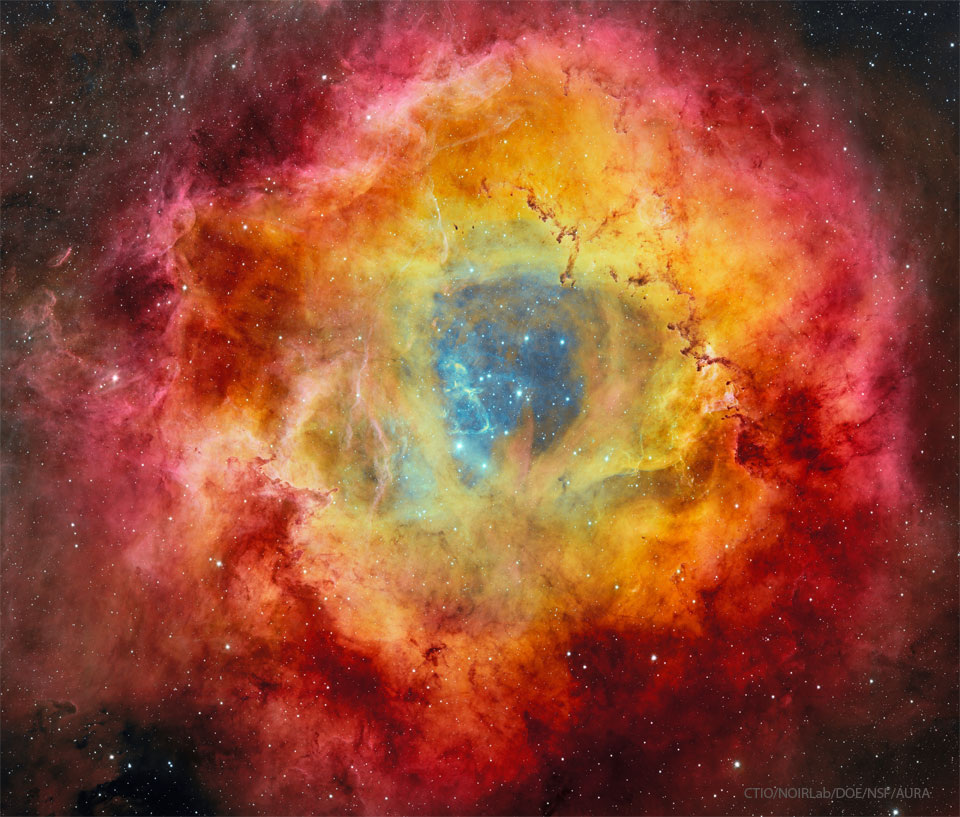APOD.pl: Astronomiczne zdjęcie dnia
Codziennie nowy obraz lub zdjęcie naszego fascynującego Wszechświata
wraz
z krótkim objaśnieniem napisanym przez zawodowego astronoma.
Zobacz więcej!
16 lipca 2025

Mgławica Rozeta z kamery DECam
Źródło:
CTIO,
NOIRLab,
DOE,
NSF,
AURA;
obróbka graficzna:
T. A. Rector
(U. Alaska Anchorage),
D. de Martin
NOIRLab (NSF-u)
oraz
M. Zamani
Opis:
Czy ta Mgławica Rozeta
wydawałaby się nam aż tak urocza, mając jakąś inną nazwę?
Nijakie oznaczanie katalogowe z Nowego Katalogu Ogólnego
(ang. New General Catalog) NGC 2237 nie oddaje zbyt dobrze wyglądu tej kwiecistej mgławicy emisyjnej, tu uwiecznionej przez
Kamerę Ciemnej Energii (ang. Dark Energy Camera), przymocowanej
do 4-metrowego teleskopu Blanco w należącym do amerykańskiej
Narodowej Fundacji Nauki (ang. National Science Foundation)
Międzyamerykańskim Obserwatorium Cerro Tololo
(ang. Cerro Tololo Inter-American Observatory) w Chile.
W jej centrum znajduje się gromada otwarta jasnych, młodych gwiazd,
oznaczona jako NGC 2244.
Owe gwiazdy mają tylko kilka milionów lat i uformowały się z centralnego materiału, dzięki wiatrom gwiazdowym tworzącym dziurę -- jamę w centrum mgławicy, oddzielającym ją warstwą pyłu i gorącego gazu.
Pochodzące z gorących gwiazd gromady światło nadfioletowe powoduje, że otaczająca ją mgławica jasno
świeci.
Mgławica Rozeta rozciąga się na około 100 lat świetlnych i leży blisko 5000 lat świetlnych stąd.
Można ją podziwiać przez niewielki teleskop lub lunetę w granicach gwiazdozbioru Jednorożca (Monoceros).
Otwarta nauka:
przeglądaj 3700+ kodów w Bibliotece Astrofizycznych Kodów Źródłowych
Jutro: 3I
<
| Archiwum
| Nadsyłanie
| Lista tematyczna
| Search
| Kalendarz
| RSS
| Edukacja
| O APOD
| Forum
| >
Autorzy i wydawcy:
Robert Nemiroff
(MTU) &
Jerry Bonnell (UMCP)
Przedstawiciel NASA: Phillip Newman,
obowiązują określone prawa.
Polityka
prywatności sieci NASA oraz ważne uwagi
Serwis prowadzony przez:
ASD w
NASA /
GSFC
oraz Michigan Tech. U.
